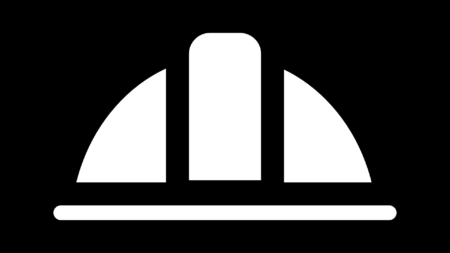The dynamics of a construction project often can lead to undesired impacts on the project’s initial program. Project delays typically come associated with a financial burden and undesired consequences for both parties: owners are prevented from using the asset on the originally planned date, and contractors usually spend more than anticipated in their budget.
Naturally, the prolongation of construction programs is commonly related to extension of time (EOT) claims, conflicts between the parties, and, sometimes, even legal disputes.
Within this context, it is imperative to understand the concepts of delay and disruption and the differences between them. Even though they both result from certain events, their impacts on construction projects can be distinct, as shown in this article. Understanding the role of liquidated damages in construction contracts is also crucial.
This blog post will review the nuances of delays and disruptions in construction contracts, shedding light on the associated costs and legal aspects. Additionally, we’ll delve into the concept of liquidated damages and explore how they serve as contractual safeguards.
Delay and Disruption in Construction Contracts
In the construction industry, the concepts of delay and disruption are frequently interchanged despite arising from distinct events. While both are consequences of specific events, their impacts on construction projects typically stand apart.
The confusion between concepts of delay and disruption is common among construction professionals because of their interconnected nature, where the occurrence of one can act as a precursor to the other. For example, disruptions can lead to delays and delays can lead to disruptions, creating a cyclical pattern in construction projects.
While delays are associated with unforeseen extensions of the project timeline (for example, delays to site access), disruption events involve interference with the planned initial course of work (for example, impact on productivity rates derived from the owner’s direction or changes, such as change in design aspects).
The next sections below will further explore the difference between these two concepts.
What is considered delay in construction contracts?
Within construction contracts, the term “delay” is associated with a task or a group of tasks taking longer to complete than the original construction plan. Typically, under the critical path method (CPM), delays are classified into:
- Critical Path Delays – These occur when there’s a delay in any activity on the critical path. Such delays have a direct and significant impact on the project completion time.
- Non-Critical Path Delays – Delays in activities that are not on the critical path and do not impact the overall project duration. However, they can still affect individual tasks, leading to resource conflicts or other issues.
From a contractual perspective, delays are normally managed through the extension of time (EOT) claim clauses, which govern critical aspects, such as:
- conditions precedent for entitlement to extension of project dates,
- specific events that might lead or not to the EOT grant,
- ownership of program float,
- cost recovery mechanisms and liquidated damages relief, and
- other aspects.

Delays in Construction Projects - Examples
Some common delays in construction projects are associated with:
Examples of Delays in Construction Projects | Examples |
Unforeseen site conditions | Latent Conditions, such as buried/unknown utilities leading to impacts on construction program. |
Inclement Weather | Excessive rainfall causing completely halt on certain activities |
Site Access | Delays to access to site causing delays to the entire project |
Poor Performance by Contractor | Contractor unable to perform in accordance with original plan, given lack of resources, experience, and/or specific equipment |
Suggested Reading: What is a Latent Condition in Construction?
What is considered disruption in construction contracts?
In a construction project, disruption is usually associated with negative impacts caused by one party (e.g. the client) to the other (e.g. the contractor), which leads to lower productivity than initially planned.
The Delay and Disruption Protocol by the Society of Construction Law defines disruption as “…disturbance, hindrance or interruption to a Contractor’s normal working methods, resulting in lower productivity or efficiency in the execution of particular work activities.”
Whilst disruption might not necessarily be linked to delays in the overall construction program, it might cause the contractor to deploy more resources than initially thought, leading to potential financial losses.
For example, consider the project/example below with five activities:
- A – Duration 4 weeks (critical path activity),
- B – Duration 6 weeks (critical path activity),
- C – Duration 3 weeks (critical path activity),
- D – Duration 3 weeks (critical path activity),
- E – Duration 2 weeks (non-critical path activity),
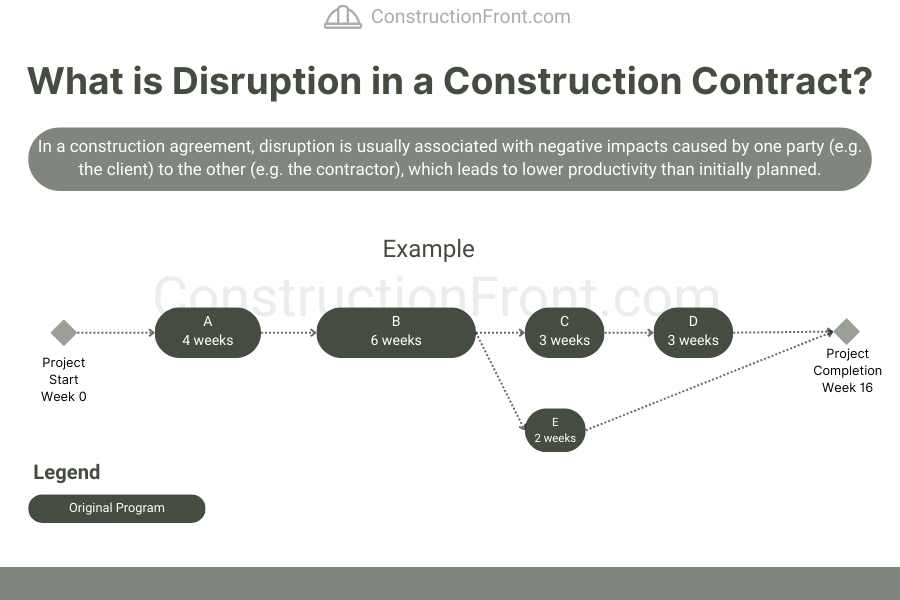
In case of activity E gets disrupted and takes three (3) weeks to complete instead of two (2) weeks, the overall project completion will not be impacted; however, the extended duration of the disrupted activity might lead to expenses (i.e. losses) not anticipated by the contractor, which might give rise to compensation entitlement.
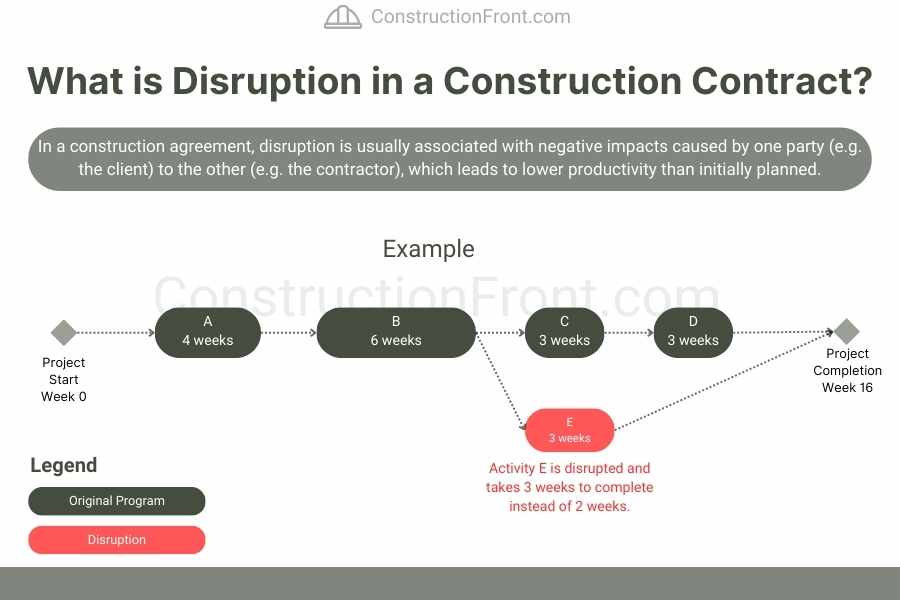
Upon the review of the disrupted program in the example, you can note that:
- As previously mentioned, the disruption does not necessarily translate into a project delay.
- Whilst Activity E took longer than 2 weeks, it did not impact the project completion within 16 weeks (because E had 4 weeks of float).
- However, disruption can also lead to compensation entitlement, given the extended duration of activity, which the contractor did not initially anticipate.
Another important aspect to highlight is that if the disruption consumed all the existing float – e.g. the disruption in activity E led it to take seven weeks instead of 2 weeks – the disruption would also have caused a delay to the project, which would have taken 17 weeks to reach completion.
Author’s Note:
- In this context, it is essential to understand and draft a construction contract that is clear on who owns the float in the construction program.
- Typically, the float is shared between both parties on a first-come-first-served basis, but, ultimately, the contract drafting will dictate the answer.
- Suggested reading: What is the Float in a Construction Program? (Who owns it?)
Disruption in Construction Projects - Examples
Some common situations that lead to disruption in construction projects are:
Examples of Disruption in Construction Projects | Examples |
Changes in Requirements / Design Modifications | Client-requested alterations to project scope, technical specifications, and design taking longer than expected |
Inadequate Communication | Unclear directions, lack of or non-timely response for Request for Information (RFIs), |
Variation Orders / Scope Creep | Gradual expansion of project scope beyond the initially agreed-upon parameters |
Inclement Weather | Excessive Rainfall impacting on productivity rates of earthworks |
Delay vs Disruption - What is the difference?
Construction professionals often interchange the terms ‘delays’ and ‘disruptions’ due to their intrinsic connection; however, as discussed earlier, their conceptual distinctions are noteworthy.
In essence, delays are associated with extending the construction program beyond the initial plan. On the other hand, disruptions are related to unexpected events that impact an activity’s planned performance, typically resulting in reduced productivity but not necessarily linked to an overall program delay.
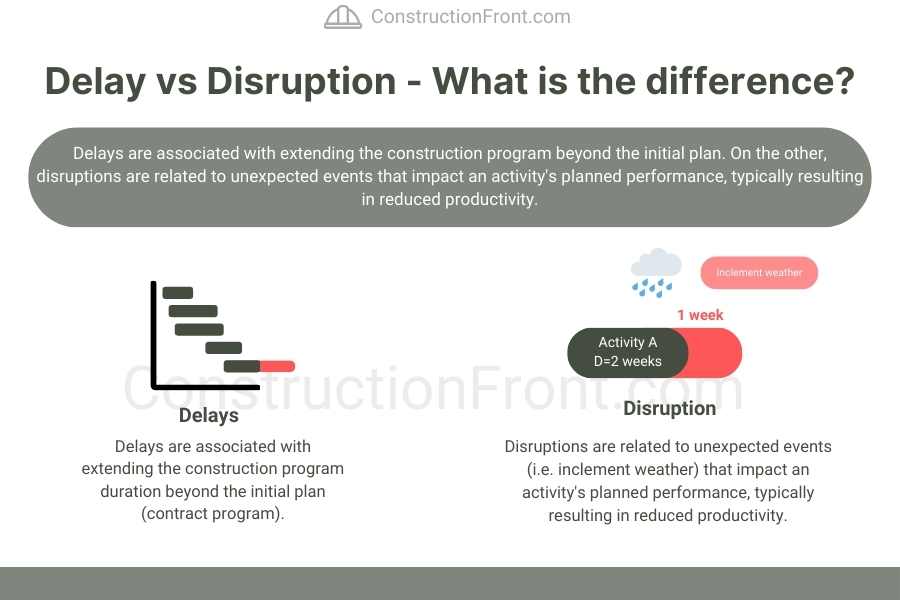
It is worth noting that if the disrupted activity is part of the project’s critical path, a disturbance to a critical task is likely to result in project delays unless the contractor promptly implements mitigation measures, such as deploying extra labor or machinery to counteract the disruptive event, which, might in turn, lead to extra costs.
Delay vs Disruption - Contractual Mechanisms
Given their different nature, delays and disruptions are usually dealt with through different contractual/commercial standpoints and mechanisms.
- Delays are typically governed by extension of time claims, in which the Contractor should focus on substantiating that the event that caused the delay is an excusable delay (i.e., a specific type of delay that entitles the Contractor to an EOT). As such,
- Disruption is often associated with a claim for the cost of lost productivity, in which the Contractor should focus on substantiating how the disturbance events caused an increased financial burden.
What are liquidated damages under a construction contract?
Very often, the discussions around delays and disruptions in a project are contentious, leading to potential disputes and compensation requests from one party to the other. For this reason, construction agreements started to specify and define liquidated damages.
Liquidated damages (LDs) are predetermined amounts of compensation set in a contract to be paid by a party (Contractor) if they fail to meet certain contractual obligations or deadlines (e.g. program/contracted dates).
They are typically agreed upon in advance and serve as a measure of foreseeable losses in case of a breach. The purpose is to provide a straightforward, predetermined remedy without requiring lengthy legal proceedings to determine the losses suffered.
For example, a construction contract may stipulate liquidated damages at $30k per day if a Contractor does reach project completion by a specific date under the contract.
Suggested Reading: Liquidated Damages in Construction Contracts – An In-Depth Review
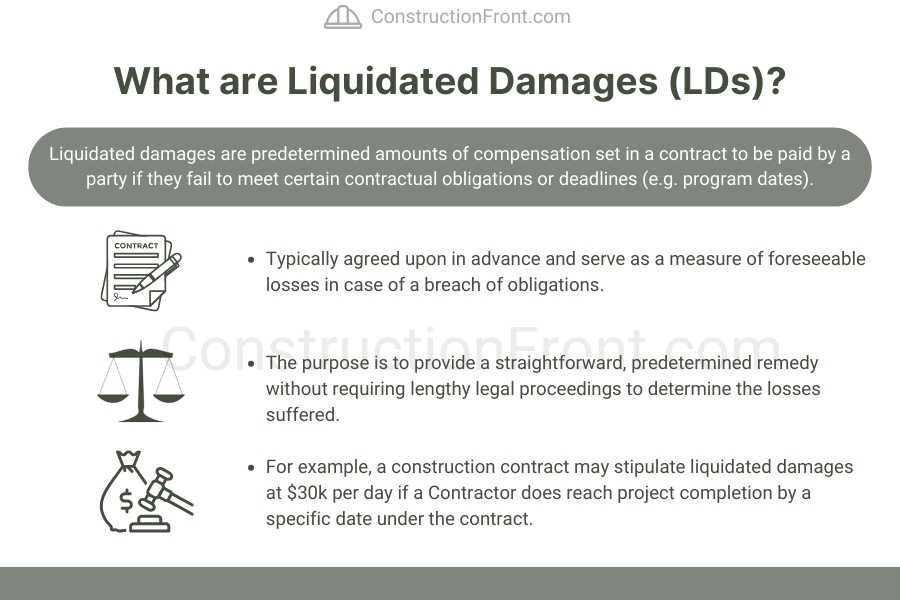
What is the purpose of Liquidated Damages in a construction contract?
Some of the advantages of including liquidated damages in a construction agreement are:
- Time Management: It encourages timely completion and is a financial incentive for contractors to complete the project on schedule.
- Risk Allocation: Place responsibility for delays on the party best able to control them.
- Contractual Certainty: Specify predetermined financial consequences for delays, ensuring clarity.
- Dispute Prevention and Fair Compensation: Prevent disputes over actual damages by using agreed-upon compensation and provide a fair and reasonable estimate of potential damages due to delays
FAQ - Delay, Disruption, and Liquidated Damages
What is an Extension of time (EOT) Claim?
An Extension of Time (EoT) claim is a formal request made by one party, typically the contractor or builder, to the other party, which may be the client, principal, or employer.
The purpose of this request is to seek an extension for specific dates specified in the contract. These dates can include project milestones, substantial completion, overall completion, or any other dates outlined in the agreement, such as incentive payment dates.
Suggested Reading: What is an Extension of Time Claim?
What are prolongation costs?
Prolongation costs are extra expenses incurred when a project takes longer than planned. They include additional labor, equipment, and overhead costs associated with the extended project duration.
What is a concurrent delay?
A concurrent delay refers to a situation in a project where two or more independent delays, caused by different factors and parties, happen simultaneously, contributing to an overall delay in the project schedule (e.g. one delay is caused by the Owner and a parallel delay is caused by the Contractor/Builder)
Liquidated Damages vs Delay Damages - What is the difference?
The terms Delay damages and Liquidated Damages are often used interchangeably, but they might have different meanings depending on the contract definitions/drafting.
- Delay damages clauses under a construction contract are typically drafted to compensate Employers/Owners for losses incurred as a consequence of a project’s late completion (for example, loss of rental income because of late completion of a building).
- Liquidated damages are usually drafted with the same intent. However, they typically specify a predetermined amount (usually, a specific sum per day – e.g. 50k / day) to be paid by the Contractor to the Employer/Owner in case of project completion delays. The purpose of liquidated damages is to simplify the compensation process by providing a predetermined fee to remedy delays.
Liquidated Damages vs Unliquidated Damages - What is the difference?
Liquidated damages are predetermined and specified in the contract, providing a clear and fixed amount for damages in case of a breach.
Unliquidated damages, however, are not pre-determined and require an assessment or determination of the actual losses incurred in the event of a breach.
Need Help?
Do not hesitate to contact us (click here) for specialised advice in the construction industry.
Sources
- Delay and Disruption Protocol by the Society of Construction Law – UK
- Structuring a delay and disruption claim: An application of cause-mapping and system dynamics – ScienceDirect
- The Assessment of Liquidated Damages under a Construction Contract 17 Mississippi Law Journal 1945-1946 (heinonline.org)
- Extension of Time and Liquidated Damages In Construction Contracts
- The Relationship Between Interest and Liquidated Damages in Construction Contracts
- AN INVESTIGATION INTO THE USE OF CONSTRUCTION DELAY AND DISRUPTION ANALYSIS METHODOLOGIES
- Avoiding and Mitigating Delay and Disruption Claims Conflict: Role of Precontract Negotiation | Journal of Legal Affairs and Dispute Resolution in Engineering and Construction
- Liquidated Damages and Extensions of Time: In Construction Contracts – Brian Eggleston
- Thinking about Delay, Disruption, and the Cumulative Impact of Multiple Changes (ascelibrary.org)
Disclaimer: The articles on this blog are for informational and educational purposes only and do not constitute legal advice. While we strive to provide accurate and up-to-date information on construction law, regulations may vary by jurisdiction, and legal interpretations can change over time.

